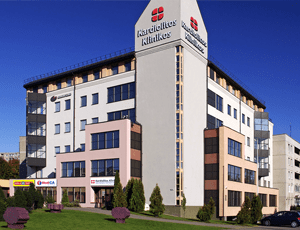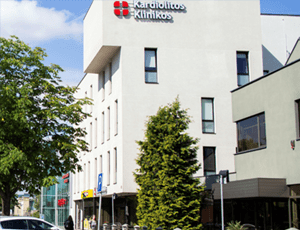Treatment cost

Kardiolita Hospital, Vilnius located in Vilnius, Lithuania is accredited by JCI. Also listed below are some of the most prominent infrastructural details:


Apart from in-detail treatment procedures available, Kardiolita Hospital, Kaunas located in Kaunas, Lithuania has a wide variety of facilities available for International Patients. Some of the facilities which are provided by them are Accommodation, Airport Transfer, Choice of Meals. Also listed below are some of the most prominent infrastructural details:
Craniotomy surgery is one of the most common types of brain surgery conducted to treat a brain tumor. It mainly aims at removing a lesion, tumor, or a blood clot in the brain by opening a flap above the brain to access the targeted area. This flap is removed on a temporary basis and again put in place when the surgery is done. Around 90 percent of the cases of brain tumors are diagnosed in adults aged between 55 and 65. Among children, a brain tumor is diagnosed within an age range of 3 to 12 years.
Craniotomy procedures are conducted with the help of magnetic resonance imaging (MRI) scans to reach the location precisely in the brain that requires treatment. A three-dimensional image for the same is achieved of the brain in conjunction with localizing frames and computers to view a tumor properly. A clear distinction is made between abnormal or tumor tissue and normal healthy tissue and to access the exact location of the abnormal tissue.
In a minimally invasive craniotomy procedure, a burr hole or a keyhole may be created to access the brain to fulfill the following purposes:
When there are complex craniotomies involved, the procedure may be referred to as a skull base surgery. In this kind of surgery, a small portion of the skull is removed from the bottom of the brain. This is the region where delicate arteries, veins, and cranial nerves exit the skull. Complicated planning is done to plan such craniotomies and understand the location of the lesions. This type of approach is usually employed for:
Primary brain tumors are much less common than secondary brain tumors. Primary ones are found to originate very close to the brain itself or in the tissues very close to it, such as the covering membranes of the brain, including the meninges, cranial nerves, pineal, or pituitary gland. It begins with normal cells, which at a later period undergoes some mutational errors in their DNA. The mutation triggers cells to grow and divide at a very high rate while healthy cells keep dying around it. This results in a mass of abnormal cells which gives rise to a tumor. Unlike primary tumors, the secondary tumors begin as cancer elsewhere and spread to the brain.
No matter what the goal of the surgery is, it is best to ensure that the incision is made to address the intracranial lesion keeping some principles in mind. A wide variety of intracranial processes can be done via a craniotomy with a different variety of incisions. Some of these variations include frontal craniotomy, pterional craniotomy, temporal craniotomy, decompression craniectomy, and suboccipital craniotomy.
Ask your healthcare adviser for the best multiple options and choose the one that meets your expectations
Craniotomy cost in Vilnius varies from one hospital to the other. The cost quoted by some of the best hospitals for Craniotomy in Vilnius generally covers the pre-surgery investigations of the patient. The Craniotomy package in Vilnius includes the fees of the surgeon, hospitalization and anesthesia as well. Stay outside the package duration, port-operative complications and diagnosis of a new condition may further increase the Craniotomy cost in Vilnius.
There are several best hospitals for Craniotomy in Vilnius. The following are some of the most renowned hospitals for Craniotomy in Vilnius:
Upon discharge from the hospital after Craniotomy in Vilnius, the patients are advised to stay for about 23 days for recovery. This time frame is important to ensure that the surgery was successful and the patient is fit to fly back.
Vilnius is one of the most popular cities for Craniotomy in the world. The country offers the best cost of Craniotomy, best doctors, and advanced hospital infrastructure. there are a select few destinations that provide comparable quality of healthcare for the procedure. Some of such cities are:
Apart from the Craniotomy cost, there are a few other daily charges that the patient may have to pay. These include the cost of accommodation and meals outside hospital. The per day cost in this case may range from 50 USD.
Patients who are interested in availing telemedicine consultation before they travel for Craniotomy in Vilnius can opt for the same. There are many kidney transpant surgeons who offer video telemedicine consultation, including the following:
Some of the most sought after doctors available for online video consultation for Craniotomy in Vilnius are:
| Doctor Name | Cost | Book Appointment |
|---|---|---|
| Dr. Jevgenijus Skuryginas | 155 | Book Now |
| Dr. Jurgita Vainauskiene | 155 | Book Now |
After Craniotomy surgery, the patient is supposed to stay for about 5 Days in the hospital for recovery and monitoring. During the recovery, the patient is carefully monitored and control tests are performed to see that everything is okay. If required, physiotherapy sessions are also planned during recovery in hospital.
There are around 1 Hospitals hospitals in Vilnius that offer Craniotomy to international patients. These hospitals have the required infrastructure and a decided Craniotomy unit where renal failure patients can be treated. Additionally, these hospitals are known to comply with the international standards as well as local legal requirements for the treatment of patients.